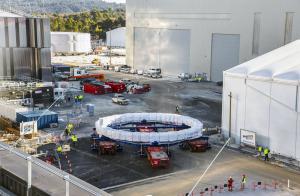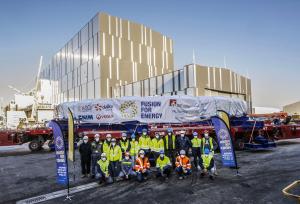12 months saved on number two
Whatever their size or position, the role of the ITER poloidal field coils is to shape and stabilize the plasma inside the vacuum vessel. However, as the plasma is not vertically symmetrical, the strength of the magnetic field the coils need to exert in order to create and maintain "plasma equilibrium" depends on their location. For instance, although they are the same size (17 metres in diameter), PF5, located below the mid-plane of the vacuum vessel, will generate a much stronger magnetic field than PF2, located above. And the same goes for bottom coil PF6 and top coil PF1, or for "middle coils" PF4 and PF3. Because the magnetic field is defined by the intensity of the electric current times the number of conductor turns, the coils encircling the upper half of the tokamak are much lighter than their siblings installed below.
At 204 tonnes, PF2 weighs approximately 120 tonnes less than PF5 despite an identical diameter. This is explained by the fact that PF2 comprises six double pancakes, each wound from two layers of 10 conductor turns (6 km of superconducting cable in all), whereas PF5 comprises eight double pancakes, wound from two layers of 14 conductor turns each (11.5 km of superconducting cable in all).
Fewer turns is not the only reason that PF2 was produced in record time—fully 12 months less than its sibling PF5. Such a remarkable result can be credited also to the "lessons learned" during the fabrication of the first coil. "Several factors contributed to reducing the manufacturing time," explains Pierre Gavouyère-Lasserre, Deputy Project Manager for poloidal field coils at the European Domestic Agency Fusion for Energy. "Some have to do with the physical rearrangement of the facility, such as the partition into two main areas, each under the responsibility of one contractor. A building extension was also created, which gave us an additional working station and allowed us to reconfigure the whole workshop."
The improvement of tooling performance through better preventive and corrective maintenance activities also played its part, as did the installation of a third overhead crane to facilitate the management of coactivity in the workshop. It is the human factor, however, which seems to have had the strongest effect on manufacturing performance. "The acquired knowledge, skills and experience of the operators (both on machine control and manual operations), the synergy between the different actors, and a better management of the interfaces between our six contractors decisively contributed to the operation's success."
PF4 will be the next poloidal field coil to exit the workshop, finalized and handed over to the ITER Organization during the first semester of 2023. PF3 will follow approximately one year later.
See a recent update on poloidal field coil manufacturing from Fusion for Energy.



